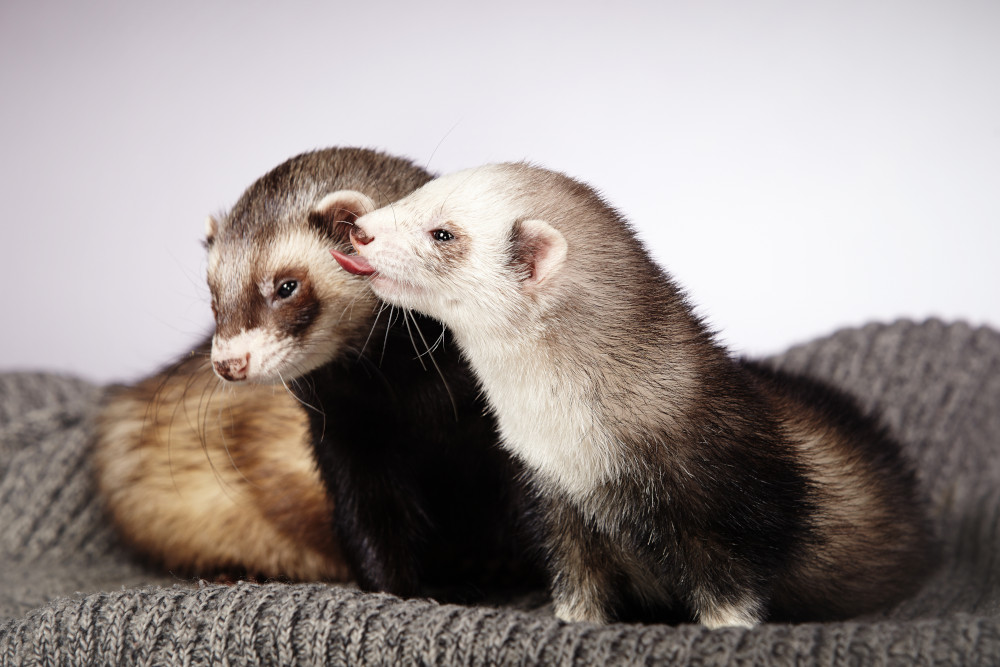
Some important things to know about ferrets and reproduction:
- A male ferret is called a ‘hob’.
- A female ferret is called a ‘jill’.
- Jills are ‘induced ovulators’. This means that the release of eggs (ovulation) from the jill’s ovaries is induced by mating. If the jill does not ovulate, she will stay in persistent oestrus and continue to produce oestrogen – in essence she will remain in season (oestrus) indefinitely if not mated (or stimulated to ovulate).
- Persistent oestrus can lead to life-threatening oestrogen-induced bone marrow suppression and poor immune function, hair loss, bleeding, anaemia, and potentially death. This means that some form of reproductive control is essential to protect the health of jills.
Reproductive control in both hobs and jills can have significant benefits, including the following:
- It prevents persistent oestrus in female ferrets (jills) which can be life-threatening.
- It stops unwanted pregnancies and, so, reduces the number of unwanted pet ferrets born and, subsequently, entering shelters or being given away.
- It can reduce the strong musk-like odour of many ferrets (especially hobs). This smell arises from their sebaceous (oil) glands in the skin, not from the anal glands as was once believed.
- Sterilised ferrets generally socialise with each other (and with people) better than non-desexed ferrets.
- Sterilisation can also reduce certain behaviours such as aggression and urine marking.
There are various options available to prevent the health issues associated with persistent oestrus in jills and unwanted pregnancies, and reduce undesirable hormone-linked behaviours and scent. These include surgical sterilisation, medical contraception, or a combination of both. There are other options to prevent persistent oestrus in jills, but these are generally not very applicable in companion ferrets (e.g., allowing her to breed each year or using a ‘teaser’ or vasectomised hob to stimulate ovulation in the jill).
Sterilisation includes all procedures and techniques that render the animal unable to produce offspring.
Surgical sterilisation is performed by a veterinarian under general anaesthesia and is a ‘one-off’ permanent means of sterilisation. There are various types of surgical sterilisation, including:
- Desexing – castration (where the testicles of the hob are removed) and spaying (ovariohysterectomy in which the ovaries and uterus of the jill are removed or ovariectomy in which the ovaries of the jill are removed). These surgical sterilisation options prevent persistent oestrus in jills and unwanted pregnancies and reduce undesirable hormone-linked behaviours and scent described above.
- Another surgical sterilisation option for hobs is vasectomy in which the tubes that carry sperm from the hob’s testicles to the urethra are cut, tied, or otherwise sealed). This will prevent unwanted pregnancies but has few other advantages, as the undesirable hormone-linked behaviours and scent issues are not addressed.
The decision about if and when to surgically sterilise ferrets is more complicated than in many companion animals as, in both sexes, surgical sterilisation can be associated with hyperadrenocorticism (a condition where there are abnormally high levels of the hormone cortisol), especially if performed before puberty. This can lead to problems such as hair loss, itchiness, and urinary blockage.
Non-surgical sterilisation (essentially medical contraception) in ferrets is currently typically a gonadotropin-releasing hormone agonist implant inserted under the skin, which can usually be done while the ferret is conscious – without general anaesthesia. This implant effectively reduces hormone levels in both hobs and jills, and so reduces the risk of the health issues associated with persistent oestrus in jills and the undesirable testosterone-linked behaviours and scent in hobs and prevents unwanted pregnancy in jills. The implants will need to be replaced every 1-2 years (the duration of action varies in different individuals) throughout the ferret’s life.
Other options for medical contraception may be available. The main advantage of medical sterilisation is that it associated with a reduced risk of adrenal disease developing in ferrets compared to surgical sterilisation.
Given the importance of reproductive control and complicated associated considerations in ferrets, it is important to discuss how to balance the benefits and risks of all the options with your veterinarian to decide what is the right approach for your ferrets.
References
Harris L (2015) Ferret Wellness Management and Environmental Enrichment. Veterinary Clinics of North America: Exotic Animal Practice 18:233–244
Vinke C, Schoemaker NJ, van Zeeland YRA (2019) Ferrets (Mustela putorius furo). Companion Animal Care and Welfare: The UFAW Companion Animal Handbook
RSPCA UK (2023) Neutering and contraception methods for ferrets. Accessed 7 Jul 2023
Chitty JR, Johnson-Delaney CA (2016) Ferret Preventive Care. In: Ferret Medicine and Surgery, 1st ed. CRC Press, pp 85–93
